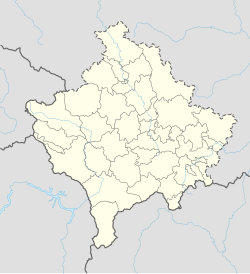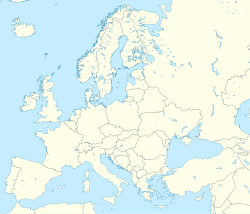Skenderaj
Skenderaj
| |
|---|---|
Town and municipality | |
From the top, Skenderaj Town Centre, Skenderaj Mosque, Ilaz Kodra Sports Hall | |
| Coordinates: 42°44′N 20°47′E / 42.733°N 20.783°E | |
| Country | Kosovo |
| District | Mitrovica |
| Named for | Skanderbeg[1] |
| Government | |
| • Mayor | Fadil Nura (PDK) |
| • Rank | 11th in Kosovo |
| • Municipal | 374 km2 (144 sq mi) |
| Elevation | 620 m (2,030 ft) |
| Population (2011) | |
| • Urban | 9,372 |
| • Municipal | 50,858 |
| • Municipal density | 140/km2 (350/sq mi) |
| Time zone | UTC+1 (CET) |
| • Summer (DST) | UTC+2 (CEST) |
| Postal code | 41000 |
| Area code | +383 28 |
| Vehicle registration | 02 |
| Website | Official site |
Skenderaj (Albanian definite form: Skënderaji) or Srbica (Serbian Cyrillic: Србица) is a town and municipality located in the Mitrovica District of Kosovo. According to the 2021 census, the municipality of Skënderaj has 52,586 inhabitants.[2]
It is the largest city in the Drenica geographical region of Kosovo.[3] It is mainly populated by ethnic Albanians. It is the place where the Kosovo War began in 1998, and to which the most damage was done.[3]
Etymology
Albanians use the name Skenderaj from the name Skanderbeg,[1] while the Serbian name was applied after the First Balkan War in an attempt to naturalize the region.[4]
Geography
The settlement is by the Klina river, in the Klina field.[5] It is the main settlement of the Drenica region.[5] The Klina river belongs to the Metohija region, while the settlement morphologically and hydrologically gravitates towards the Kosovo region.[5]
The municipality covers an area of 378 km2, including the town of Skenderaj and 49 villages.
History
The village of Runik, 10 kilometres (6.2 mi) northwest of Skenderaj, is one of the most prominent Neolithic sites in Kosovo to date, contains artefacts from the Starcevo and Vinca cultures. Research was conducted in about 35 private parcels in the Dardania neighborhood of Runik. Starcevo and Vinca pottery fragments dating to 6500-3500 BC have been found at the site. A significant find is a baked-clay ocarina 8 centimetres (3.1 in) in length, known as the Runik Ocarina, the oldest musical instrument found in Kosovo to date.[6]

The municipality cadastral area includes several settlements that existed during the Middle Ages, among which some exist still today, such as Liqinë, Polac, Banjë, and others.[7] There are ruins of a church dating to the 14th century in southern Leqinë.[8] The Church of St. Nicholas was built in 1436, in Banjë, as the endowment of Serbian magnate Rodop.[9] The Devič monastery was built in Llausha near Skënderaj in the 15th century, dedicated to the local monk, St. Joanikije (d. 1430).[10] The Church of St. John was built in the 16th century on the ruins of a 14th-century church, in Leqinë; the church is surrounded by an old and large Serbian graveyard with tombs dating to the 17th–19th centuries.[11] A 16th-century church and cemetery is located in Runik.[12]

In the early 20th century Albanian resistance began with the Kachak movement led by Azem Bejta and his wife Shote Galica, who fought against Bulgarian, Austro-Hungarian and Yugoslav forces.[13] At the end of World War II in 1944, the leader of the Drenica Brigade Shaban Polluzha refused to lead his 12,000 men north and join the Partisans in order to pursue the retreating Germans, because Serbian Chetnik groups were attacking the Albanian population in Kosovo.[14]
Modern
During the Kosovo War, Serbian forces reportedly emptied the town of its Albanian inhabitants and executed approximately 115 ethnic Albanian males over the age of 18.[15] Serbian authorities reportedly were holding detainees in an ammunition factory in the town.[16]
Economy
Skënderaj has historically been the poorest municipality in Kosovo, with little investment having been made since the time of the former Yugoslavia. It suffers from low economic activity and continuous high unemployment. Agriculture is the major local industry but the municipality has not fully developed existing arable land. Today, the local economy consists of small enterprises such as family-run shops and restaurants while two privatized factories, a brick and a flour mill, employ a few hundred people. The other major sector of employment is the municipality's civil service.[3]
Sport
Skënderaj is home of the football club KF Drenica, which plays their home games in the Bajram Aliu Stadium and competes in the second tier league called First Football League of Kosovo. Skënderaj is also home of the Kosovar Superliga volleyball club KV Skenderaj women's and KV Drenica men's.
Cultural heritage
- Devič, Serbian Orthodox abbey
Demographics
| Year | Pop. | ±% p.a. |
|---|---|---|
| 1948 | 23,744 | — |
| 1953 | 26,166 | +1.96% |
| 1961 | 30,308 | +1.85% |
| 1971 | 36,660 | +1.92% |
| 1981 | 46,927 | +2.50% |
| 1991 | 55,471 | +1.69% |
| 2011 | 50,858 | −0.43% |
| 2024 | 40,632 | −1.71% |
| Source: Division of Kosovo | ||
According to the last official census done in 2011, the municipality of Skenderaj has 50,858 inhabitants.
Ethnic groups
The ethnic composition of the municipality:
| Ethnic group | 1991 census | 2011 census |
|---|---|---|
| Albanians | 54,437 | 50,685 |
| Serbs | 713 | 50 |
| Bosniaks | - | 42 |
| Ashkali and Egyptians | 37 | 11 |
| Others | 284 | 70 |
| Total | 55,471 | 50,858 |
Notable people
- Adem Jashari, Kosovo Liberation Army leader, born in Prekaz
- Tahir Meha, famous Albanian political activist
- Malush Ahmeti, prominent Kosovo Liberation Army commander
- Hashim Thaçi, President of Kosovo (2016–2020)
- Hamëz Jashari, co-founder of KLA and brother of Adem Jashari
- Hasan Prishtina, political leader of Albanian National Movement
- Sylejman Selimi, comrade of Jashari
- Shote Galica, Kachak leader
- Përparim Hetemaj, footballer
- Mehmet Hetemaj, footballer
- Ahmet Delia, activist of League of Prizren
- Gazmend Çitaku, (born 4th of December 1970) photographer, publisher, and librarian, born in Skenderaj.
- Ilaz Kodra, KLA commander
See also
References
- ^ a b "Kjo është historia e emrit Skenderaj e domëthënia e tij, mësoje historinë si u bë komunë Skenderaj" [This is the story of the name Skenderaj and its meaning, learn the story of how Skenderaj became a municipality]. Drenica Press (in Albanian). 28 November 2016.
- ^ "Skenderaj (Gemeinde, Mitrovicë, Kosovo) - Einwohnerzahlen, Grafiken, Karte und Lage". www.citypopulation.de. Retrieved 2024-07-25.
- ^ a b c "OSCE Municipal Profile, April 2008" (PDF). Archived from the original (PDF) on 2019-12-01. Retrieved 2008-06-06.
- ^ Argumentet dhe metodat e politikes ekspansioniste Serbe per ta sunduar Kosoven nga akademik Mark Krasniqi
- ^ a b c Marković 1967, p. 407.
- ^ Berisha 2012, p. 18.
- ^ Božanić, S. (2009). "O zemljišnim međama srpskog srednjovekovnog sela" (PDF). Istraživanja (20): 47–64.[permanent dead link]
- ^ "Преобрашка-Калуђерска црква". Споменици културе у Србији.
- ^ "Црква Св. Николе". Споменици културе у Србији.
- ^ "Манастир Девич у близини Србице". Споменици културе у Србији.
- ^ "Црква Св. Јована". Споменици културе у Србији.
- ^ "Црква Св. Ђорђа са гробљем". Споменици културе у Србији.
- ^ Elsie, Robert (2004). Historical Dictionary of Kosova. The Scarecrow Press. p. 63. ISBN 0-8108-5309-4.
- ^ Robert Elsie (1 December 2010). Historical Dictionary of Kosovo. Scarecrow Press. p. 219. ISBN 978-0-8108-7231-8. Retrieved 30 August 2012.
- ^ Erasing History: Ethnic Cleansing in Kosovo. Department of State. 1999. ISBN 978-0-16-050065-7.
- ^ Erasing History: Ethnic Cleansing in Kosovo. Department of State. 1999. ISBN 978-0-16-050065-7.
Sources
- Berisha, Milot (2012). "Archaeological Guide of Kosovo" (PDF). Ministry of Culture of Kosovo.
- Radovanović, Milovan (2004). Etnički i demografski procesi na Kosovu i Metohiji. Liber Press. ISBN 9788675560180.
- Marković, Jovan Đ. (1967). Geografske oblasti Socijalističke Federativne Republike Jugoslavije. Zavod za izdavanje udžbenika Socijalističke Republike Srbije.








